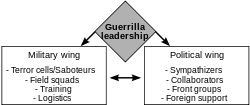|
People's war
People's war or protracted people's war is a Maoist military strategy. First developed by the Chinese communist revolutionary leader Mao Zedong (1893–1976), the basic concept behind people's war is to maintain the support of the population and draw the enemy deep into the countryside (stretching their supply lines) where the population will bleed them dry through guerrilla warfare and eventually build up to mobile warfare. It was used by the Chinese communists against the Imperial Japanese Army in World War II, and by the Chinese Soviet Republic in the Chinese Civil War. The term is used by Maoists for their strategy of long-term armed revolutionary struggle. After the Sino-Vietnamese War in 1979, Deng Xiaoping abandoned people's war for "People's War under Modern Conditions", which moved away from reliance on troops over technology. With the adoption of "socialism with Chinese characteristics", economic reforms fueled military and technological investment. Troop numbers were also reduced and professionalisation encouraged. The strategy of people's war was used heavily by the Viet Cong in the Vietnam War. However, protracted war should not be confused with the "foco" theory employed by Che Guevara and Fidel Castro in the Cuban Revolution of 1959. Overview
In China  In its original formulation by Chairman Mao Zedong, people's war exploits the few advantages that a small revolutionary movement has—broad-based popular support can be one of them—against a state's power with a large, professional, well-equipped and well-funded army. People's war strategically avoids decisive battles, since a tiny force of a few dozen soldiers would easily be routed in an all-out confrontation with the state. Instead, it favours a three-phase strategy of protracted warfare, with carefully chosen battles that can realistically be won.[citation needed] In phase one, the revolutionary force conducting people's war starts in a remote area with mountainous or forested terrain in which its enemy is weak. It attempts to establish a local stronghold known as a revolutionary base area. As it grows in power, it enters phase two, establishes other revolutionary base areas and spreads its influence through the surrounding countryside, where it may become the governing power and gain popular support through such programmes as land reform. Eventually in phase three, the movement has enough strength to encircle and capture small cities, then larger ones, until finally it seizes power in the entire country.[citation needed] Within the Chinese Red Army, the concept of people's war was the basis of strategy against the Japanese, and against a hypothetical Soviet invasion of China. The concept of people's war became less important with the collapse of the Soviet Union and the increasing possibility of conflict with the United States over Taiwan. In the 1980s and 1990s the concept of people's war was changed to include more high-technology weaponry.[citation needed] Historian David Priestland dates the beginning of the policy of people's war to the publication of a "General Outline for Military Work" in May 1928, by Chinese Central Committee. This document established official military strategies to the Chinese Red Army during the Chinese Civil War.[2] The strategy of people's war has political dimensions in addition to its military dimensions.[3] In China, the early People's Liberation Army was composed of peasants who had previously lacked political significance and control over their place in the social order.[4] Its internal organization was egalitarian between soldiers and officers, and its external relationship with rural civilians was egalitarian.[3] As sociologist Alessandro Russo summarizes, the political existence of peasants via the PLA was a radical exception to the rules of Chinese society and "overturned the strict traditional hierarchies in unprecedented forms of egalitarianism."[5] Other usage in Chinese rhetoricIn 2014 Party leadership in Xinjiang commenced a People's War against the “Three Evil Forces” of separatism, terrorism, and extremism. They deployed two hundred thousand party cadres to Xinjiang and launched the Civil Servant-Family Pair Up program. Xi was dissatisfied with the initial results of the People's War and replaced Zhang Chunxian with Chen Quanguo in 2016. Following his appointment Chen oversaw the recruitment of tens of thousands of additional police officers and the division of society into three categories: trustworthy, average, untrustworthy. He instructed his subordinated to “Take this crackdown as the top project,” and “to preempt the enemy, to strike at the outset.” Following a meeting with Xi in Beijing Chen Quanguo held a rally in Ürümqi with ten thousand troops, helicopters, and armored vehicles. As they paraded he announced a “smashing, obliterating offensive,” and declared that they would “bury the corpses of terrorists and terror gangs in the vast sea of the People's War.”[6] In February 2020, the Chinese Communist Party launched an aggressive campaign described by the Xi Jinping as a "people's war" to contain the spread of the coronavirus.[7] Outside ChinaIn non-communist states such as Iran, the Islamic Revolutionary Guard Corps used the protracted people's war against Iraq.[8] List of people's wars
Conflicts in the following list are failed and successful wars labelled as people's wars by Maoists, and also both failed and ongoing attempts to start and develop people's wars. In addition to the conflicts in the list, there also have been conflicts not primarily led by Maoists or seen as people's wars, but had Maoist groups involved within them who viewed the conflicts partly as such, including the Democratic Front for the Liberation of Palestine (Arab–Israeli conflict) and the Communist Party of Burma (Myanmar civil war). See also
ReferencesCitations
Sources
|
||||||||||||||||||||||||||||||||||||||||
